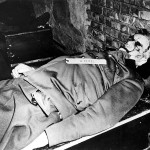
Early on the morning of 16 October 1946, Wilhelm Keitel walked up 13 steps of the scaffold, had the rope adjusted around his neck, and dropped 6 feet through the trap door. The Nuremburg Court’s verdict of death by hanging was carried out on one of the major architects and perpetrators of the Nazi war machine.
Today, we tend to see World War II through the lens of the History Channel framed by the events of Pearl Harbor, D-Day, and the Holocaust. Rarely do we dig below the surface and become exposed to the sheer brutality, horrors, and inhuman behavior of the Nazi regime and its criminals (yes, these were criminals, thugs, lowlife, misfits, and degenerates). Researching my new book Where Did They Put the Gestapo Headquarters? A Walking Tour of Nazi Occupied Paris has brought many of these barbaric events and behaviors to my attention. I have trouble comprehending so many horrific stories as I scratch the surface. One of these stories is Nacht und Nebel.
Nacht Und Nebel
One of the reasons given by the court for pronouncing the death sentence on former Generalfeldmarschall Keitel was his approval of Hitler’s directive called Nacht und Nebel (Night and Fog). Effective December 7, 1941, captured political activists, resistance members, and foreign agents were to be handed over to the Gestapo provided the prisoners were still alive after 8 days of interrogation (in other words, they had not been executed by the eighth day). The victims were always arrested at night and swiftly taken to locations far away for their interrogation sessions.
The surviving prisoners, after the interrogations, were taken to undisclosed concentration camps in the east. Friends and family were never told what happened to these unfortunate persons. All traces of their lives and fates were extinguished. Even post-war records did not give any indication a victim existed—graves were not marked. In other words, they vanished in the night and fog without leaving any traces. The Germans referred to these people as being vernebelt or transformed into mist. When the prisoners got to their final destination, their clothing was stitched with the letters NN (Nacht und Nebel) so the guards knew how to deal with them.
View this Short Video from Night and Fog:
Here’s a short clip from Night and Fog, a very famous 1955 documentary by Alain Resnais. François Truffaut claimed this documentary was one of the most important he had ever seen.
Certain camps were designated as the final destination for NN victims. One of the more infamous camps was Natzweiler-Struthof. It was the only extermination camp located within France (located in the Vosges Mountains near Strasbourg and the German border). You can visit the memorial set up at the site of the former camp. The gas chamber was located approximately 1.5 miles away from the camp but a crematorium was constructed on-site. Natzweiler-Struthof was predominately a camp for men who were either political activists or members of the resistance. The camp is also known for other acts that would make you shudder.
Visit the Natzweiler-Struthof Camp Memorial:
Natzweiler-Struthof Camp Memorial
(warning: there are some gruesome pictures)
While I don’t take you to Natzweiler-Struthof in my book, I do take you to places and sites in Paris that were infamous during the 4-year occupation. For those of you familiar with my other books (e.g., the French Revolution), you know that I start the books off with a general discussion of the event or time period that is the theme of the book. I do this to put the buildings, places, and sites into some sort of historical perspective. The beginning of the German occupation of Paris was rather benign but gathered steam as months and years went on. One of the themes of the book will be collaboration and how we view this controversial topic 70-years later.
I Was Only Following Orders
Keitel’s defense at Nuremburg was that he was only following orders. Yet he went on record as saying his biggest regret was approving the Nacht und Nebel policy. This horrible policy was declared a war crime and violated the Hague Conventions. While Keitel paid for his crimes, far too many guilty people did not.
Do we have a lot of stories? Of course we do. I’m looking forward to sharing these with you. Please continue to visit our newsletter and blog. Perhaps you’d like to subscribe so that you don’t miss out on the most recent newsletter and blog posts.
Thanks so much for following my newsletter and blogs as well as my little journey through this incredibly interesting process of writing a series of niche walking tour books based on European historical periods or events.
Share This:
Follow Stew:
Find Stew’s books on Amazon and iBooks.
Please note that we do not and will not take compensation from individuals or companies mentioned or promoted in the blogs.
Walks Through History
Copyright © 2015 Stew Ross

